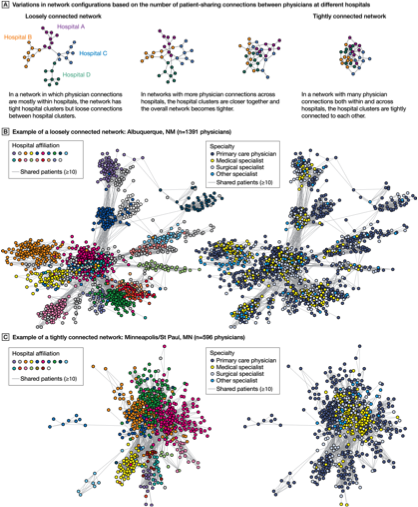
Variation in Patient-Sharing Networks of Physicians Across the United States
Abstract
Context
Physicians are embedded in informal networks that result from their sharing of patients, information, and behaviors.
Objectives
To identify professional networks among physicians, examine how such networks vary across geographic regions, and determine factors associated with physician connections.
Design, Setting, and Participants
Using methods adopted from social network analysis, Medicare administrative data from 2006 were used to study 4,586,044 Medicare beneficiaries seen by 68,288 physicians practicing in 51 hospital referral regions (HRRs). Distinct networks depicting connections between physicians (defined based on shared patients) were constructed for each of the 51 HRRs.
Main Outcomes Measures
Variation in network characteristics across HRRs and factors associated with physicians being connected.
Results
The number of physicians per HRR ranged from 135 in Minot, North Dakota, to 8197 in Boston, Massachusetts. There was substantial variation in network characteristics across HRRs. For example, the mean (SD) adjusted degree (number of other physicians each physician was connected to per 100 Medicare beneficiaries) across all HRRs was 27.3 (range, 11.7-54.4); also, primary care physician relative centrality (how central primary care physicians were in the network relative to other physicians) ranged from 0.19 to 1.06, suggesting that primary care physicians were more than 5 times more central in some markets than in others. Physicians with ties to each other were far more likely to be based at the same hospital (69.2% of unconnected physician pairs vs 96.0% of connected physician pairs; adjusted rate ratio, 0.12 [95% CI, 0.12-0.12]; P!.001), and were in closer geographic proximity (mean office distance of 21.1 km for those with connections vs 38.7 km for those without connections, P!.001). Connected physicians also had more similar patient panels in terms of the race or illness burden than unconnected physicians. For instance, connected physician pairs had an average difference of 8.8 points in the percentage of black patients in their 2 patient panels compared with a difference of 14.0 percentage points for unconnected physician pairs (P!.001).
Conclusions
Network characteristics vary across geographic areas. Physicians tend to share patients with other physicians with similar physician-level and patient-panel characteristics.
Citation:
B.E. Landon, N.L. Keating, M.L. Barnett, J.P. Onnela, S. Paul, A.J. O’Malley, T. Keegan, and N.A. Christakis, "Variation in Patient-Sharing Networks of Physicians Across the United States" JAMA: Journal of the American Medical Association, 308(3): 265-273 (July 2012); http://dx.doi.org/10.1001/jama.2012.7615